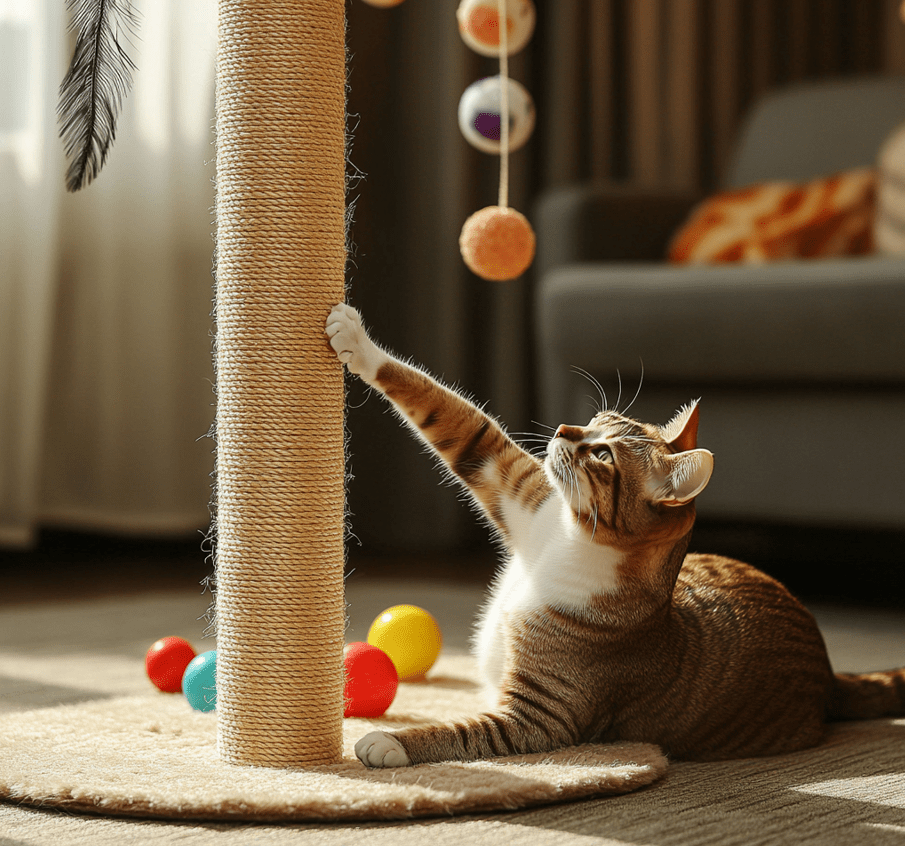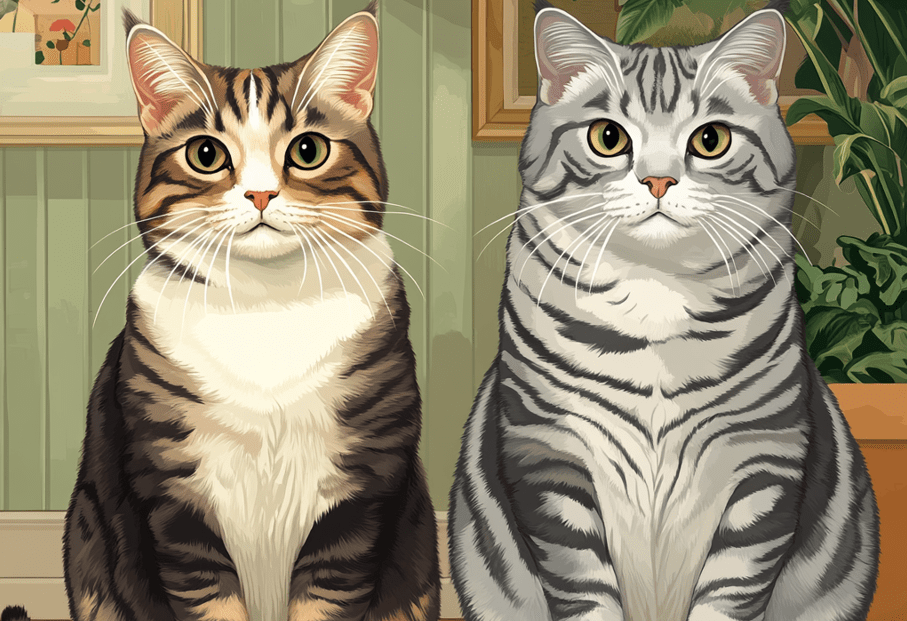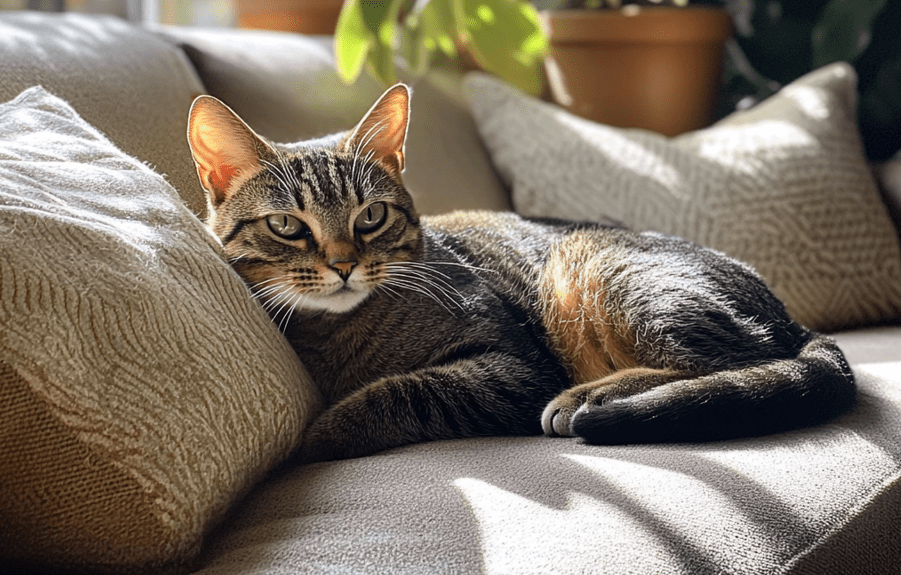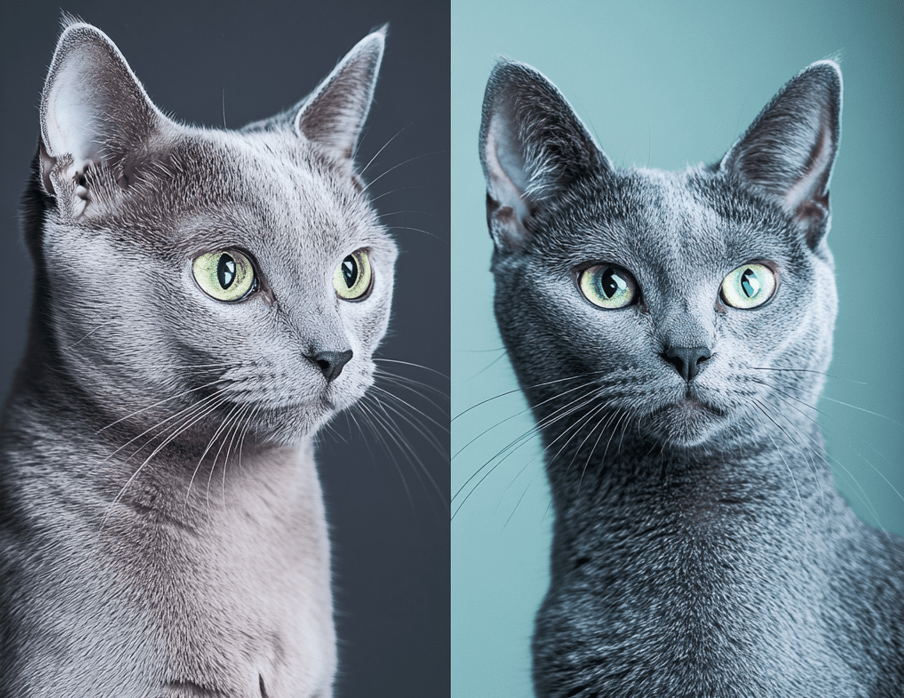
Training your Domestic Shorthair to use a scratching post can be a game-changer for both you and your feline friend. Domestic Shorthair Cats are known for their playful and independent nature, but they also have a natural instinct to scratch, which can lead to damaged furniture if not directed properly. A scratching post provides a safe and appropriate outlet for this behavior, keeping your home intact while satisfying your cat’s instincts. In this comprehensive guide, we’ll walk you through the steps to train your Domestic Shorthair to use a scratching post, along with tips, tricks, and product recommendations to make the process smooth and effective.
From understanding why Domestic Shorthairs scratch to troubleshooting common challenges, this article covers everything you need to know to succeed. Let’s get started on creating a scratch-free home for you and a happy scratching space for your cat!
Why Domestic Shorthairs Need to Scratch
Scratching is a natural and essential behavior for Domestic Shorthair Cats. Before diving into training, it’s important to understand why they scratch in the first place:
Marking Territory: Cats have scent glands in their paws, and scratching leaves both a visual mark and a scent, helping them claim their territory.
Nail Maintenance: Scratching removes the outer layer of their claws, keeping them sharp and healthy.
Stretching and Exercise: Scratching allows Domestic Shorthairs to stretch their muscles, particularly in their shoulders and back.
Stress Relief: Scratching can be a way for cats to relieve stress or boredom, acting as a self-soothing behavior.
Play and Instinct: Scratching mimics hunting behaviors, satisfying their natural instincts.
Understanding these motivations will help you approach training with empathy and patience, ensuring your Domestic Shorthair feels comfortable using a scratching post.
Benefits of Training Your Domestic Shorthair to Use a Scratching Post

Training your Domestic Shorthair to use a scratching post offers numerous benefits for both you and your cat:
Protects Furniture: Redirecting your cat’s scratching to a post saves your couch, curtains, and other household items.
Supports Cat Health: Regular scratching keeps your Domestic Shorthair’s claws healthy and provides physical exercise.
Reduces Stress: Providing an appropriate outlet for scratching helps your cat feel secure and reduces behavioral issues.
Strengthens Your Bond: Training involves positive interaction, building trust between you and your Domestic Shorthair.
Improves Home Harmony: A well-trained cat means less frustration for you and a happier living environment for everyone.
With these benefits in mind, let’s explore the steps to train your Domestic Shorthair to use a scratching post effectively.
Step-by-Step Guide: How to Train Your Domestic Shorthair to Use a Scratching Post
Training a Domestic Shorthair to use a scratching post requires patience, consistency, and positive reinforcement. Follow these steps to ensure success.
Step 1: Choose the Right Scratching Post
Not all scratching posts are created equal, and Domestic Shorthairs have specific preferences. Here’s how to pick the perfect one:
Height and Stability: The post should be tall enough for your Domestic Shorthair to stretch fully (at least 30 inches) and sturdy enough not to tip over. A wobbly post can scare your cat and deter them from using it.
Material: Most Domestic Shorthairs prefer sisal rope or fabric, as it provides a good texture for scratching. Avoid carpeted posts if your home has carpet, as this can confuse your cat.
Type: Some cats prefer vertical posts, while others like horizontal scratchers or angled boards. Observe your Domestic Shorthair’s scratching style to choose the best option.
Additional Features: Posts with toys, platforms, or perches can make the scratching post more appealing.
Step 2: Place the Scratching Post Strategically
Location is key when introducing a scratching post to your Domestic Shorthair.
Near Their Favorite Spot: Place the post near where your cat already scratches, such as by the couch or a doorway. Domestic Shorthairs are more likely to use a post if it’s in a familiar area.
High-Traffic Areas: Cats often scratch to mark territory, so place the post in a social area, like the living room, rather than a hidden corner.
Multiple Posts: If you have a large home, consider placing scratching posts in several locations to give your Domestic Shorthair options.
Step 3: Make the Scratching Post Irresistible
Encourage your Domestic Shorthair to explore the scratching post by making it more appealing than other surfaces.
Use Catnip: Sprinkle catnip on the post or rub it into the sisal. About 70-80% of Domestic Shorthairs are attracted to catnip, making it a great motivator.
Add Toys: Attach a dangling toy or feather to the post to draw your cat’s attention.

Scent Marking: Gently rub a cloth on your cat’s cheeks to collect their scent, then rub it on the post to make it smell familiar.
Scratch It Yourself: Use your fingernails to scratch the post in front of your Domestic Shorthair. Cats often mimic their owners, and this can spark their interest.
Step 4: Encourage Use with Positive Reinforcement
Positive reinforcement is the most effective way to train your Domestic Shorthair to use a scratching post.
Reward Good Behavior: When your cat uses the post, immediately reward them with treats, praise, or petting. Use high-value treats like Temptations Classic Treats to make the reward extra special.
Play Near the Post: Engage your Domestic Shorthair in play near the post using a feather wand or toy. If they scratch the post during play, reward them.
Avoid Punishment: Never yell at or punish your cat for scratching elsewhere. This can create fear and stress, making training harder.
Step 5: Discourage Scratching on Inappropriate Surfaces
While encouraging use of the scratching post, you’ll also need to deter your Domestic Shorthair from scratching furniture or other surfaces.
Cover Furniture: Use double-sided tape, aluminum foil, or plastic covers on furniture to make it less appealing for scratching. Products like Sticky Paws are designed specifically for this purpose.
Interrupt and Redirect: If you catch your Domestic Shorthair scratching the couch, gently interrupt them with a soft clap or a toy, then guide them to the scratching post and reward them for using it.
Scent Deterrents: Use citrus-scented sprays or pheromone deterrents like Feliway on furniture, as cats typically dislike these smells.
Step 6: Be Patient and Consistent
Training a Domestic Shorthair to use a scratching post doesn’t happen overnight. Cats learn at their own pace, so consistency is key.
Daily Encouragement: Spend a few minutes each day encouraging your cat to use the post, especially during times they’re most likely to scratch (e.g., after a nap).
Monitor Progress: Keep track of how often your Domestic Shorthair uses the post versus other surfaces. If they’re still scratching furniture, revisit your deterrents and rewards.
Adjust as Needed: If your cat isn’t interested in the post after a few weeks, try a different style, material, or location.
Common Challenges When Training a Domestic Shorthair to Use a Scratching Post
Even with the best approach, you might encounter challenges. Here’s how to address common issues:
Your Cat Ignores the Scratching Post
Solution: Make the post more appealing by adding catnip, toys, or treats on top. Try a different material or style, such as a horizontal scratcher if they don’t like vertical posts. Ensure the post is in a location your Domestic Shorthair frequents.
Your Cat Prefers Furniture
Solution: Make furniture less appealing with deterrents like double-sided tape or citrus sprays. Place the scratching post directly next to the furniture they’re scratching, and reward them for using the post instead.
Your Cat Seems Stressed or Resistant
Solution: Stress can make training harder. Ensure your Domestic Shorthair has a calm environment with plenty of enrichment (toys, perches, etc.). Use pheromone diffusers like Feliway to reduce anxiety, and avoid forcing them to use the post.
The Scratching Post Tips Over
Solution: A wobbly post can scare your Domestic Shorthair, making them avoid it. Invest in a post with a wide, heavy base, or secure it to the wall for added stability.
Additional Tips for Success
Here are some extra tips to enhance your training process and ensure your Domestic Shorthair loves their scratching post:

Introduce the Post Early: If you have a kitten, start training them to use a scratching post as soon as possible. Kittens are more adaptable and form habits quickly.
Multiple Cats, Multiple Posts: If you have more than one Domestic Shorthair, provide multiple scratching posts to avoid competition and ensure each cat has their own space.
Keep Nails Trimmed: Regular nail trims can reduce the damage caused by scratching while you’re training. Use cat-specific nail clippers and trim every 2-3 weeks.
Clean the Post: Over time, a scratching post can become dirty or lose its appeal. Clean it with a pet-safe cleaner and refresh the catnip regularly.
Incorporate Play: Domestic Shorthairs often scratch during or after play. Use toys like feather wands near the post to encourage scratching as part of their play routine.
Best Scratching Posts for Domestic Shorthairs
To help you get started, here are some top-rated scratching posts that Domestic Shorthairs love:
Frisco 33.5-in Sisal Cat Scratching Post with Toy: A tall, sturdy post with sisal covering and a dangling toy for extra fun.
PetFusion Ultimate Cat Scratcher Lounge: A modern, angled scratcher that doubles as a lounging spot, perfect for Domestic Shorthairs who like variety.
SmartCat Pioneer Pet Ultimate Scratching Post: A 32-inch sisal post with a wide base, ideal for stability and stretching.
Catit Scratcher with Catnip: A budget-friendly horizontal scratcher that comes with catnip to attract your Domestic Shorthair.
KONG Naturals Incline Scratcher: A slanted scratcher with a replaceable scratching pad, great for cats who prefer angled surfaces.
Why Some Domestic Shorthairs Resist Training (and How to Fix It)
If your Domestic Shorthair isn’t taking to the scratching post, there might be underlying reasons:
Stress or Anxiety: Changes in the home, new pets, or lack of stimulation can cause stress, leading to scratching on furniture as a coping mechanism. Address stress with calming aids and enrichment.
Medical Issues: Painful conditions like arthritis can make scratching uncomfortable, or overgrown claws can cause discomfort. Check with your vet if your cat seems reluctant to scratch.
Preference for Other Surfaces: If your Domestic Shorthair has a strong preference for a specific surface (like carpet), try to match the scratching post material to that texture while deterring the inappropriate surface.
Long-Term Benefits of Training Your Domestic Shorthair to Use a Scratching Post
Investing time in training your Domestic Shorthair to use a scratching post pays off in the long run. Here’s what you can expect:
Preserved Furniture: Your home stays scratch-free, saving you money on repairs or replacements.
Happier Cat: Your Domestic Shorthair will feel fulfilled by having an appropriate outlet for their scratching instincts.
Reduced Behavioral Issues: Proper scratching outlets can reduce stress-related behaviors like over-grooming or aggression.
Stronger Bond: The training process, with its focus on positive reinforcement, strengthens your relationship with your cat.
Conclusion: A Scratch-Free Home with a Happy Domestic Shorthair

Training your Domestic Shorthair to use a scratching post is a rewarding journey that benefits both you and your cat. By choosing the right post, placing it strategically, using positive reinforcement, and being patient, you can redirect your cat’s scratching instincts to an appropriate outlet. With consistency and a little creativity, your Domestic Shorthair will soon see their scratching post as their go-to spot for scratching, stretching, and marking territory.




